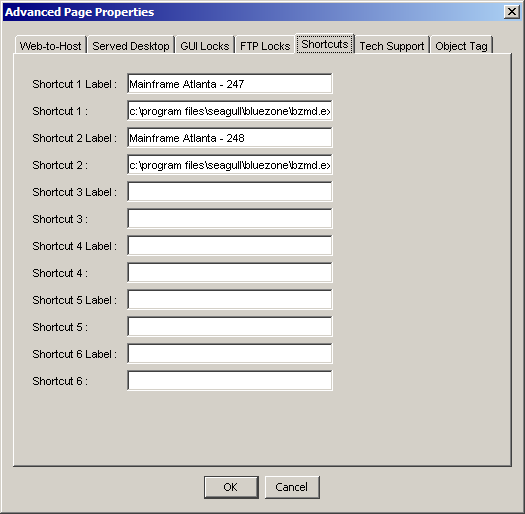
|
Wizard How To Guide |
BlueZone Web-to-Host |
Desktop Shortcuts - Click here to learn more about this feature
The Shortcuts feature can be used in several ways. The purpose of this procedure is to explain how to deliver desktop shortcuts that launch specific BlueZone configurations, when used in conjunction with the Served Desktop Deployment Mode.
This is an Advanced Global Level Feature.
If you are using specific configuration file names, you can configure the Wizard to automatically create BlueZone desktop shortcuts that launch the desired BlueZone configuration files.
This feature is often used when the BlueZone Administrator is replacing a competitor's desktop emulation program with BlueZone Served Desktop, and it is the goal of the BlueZone Administrator to replicate the competitor's desktop environment as closely as possible.
For example, let's say that your End Users are accustomed to having two (or more) desktop shortcuts that launch specific Mainframe sessions.
First create the required number of configuration files.
Add these configuration files to the files that are downloaded with the Served Desktop installation.
Create the shortcut along with the file name that you want to use to launch the session. This is done by placing the name of the shortcut along with a command line switch in the Shortcuts tab located in the Advanced Page Properties.
Create one of these entires for each shortcut that you want to deliver to your End Users.
The following screen shot shows two shortcuts along with their respective labels:

Since the window is not long enough to display the entire shortcut, here is the shortcut in its entirety:
c:\program files\seagull\bluezone\bzmd.exe /fmainframe1.zmd
Pay particular attention to the use of the /F Command Line Switch located at the end of the shortcut. This shortcut will launch a BlueZone Mainframe Display session using the configuration file named mainframe1.zmd.
 CAUTION! Do
not use any quotation marks when entering the shortcut into the Wizard.
Enter it
exactly the way it is shown above with a space before the command line
switch.
CAUTION! Do
not use any quotation marks when entering the shortcut into the Wizard.
Enter it
exactly the way it is shown above with a space before the command line
switch.
Once you have the shortcut information entered as shown, click the OK button.
Publish the launch page and test it. Make sure the desktop shortcuts work correctly.